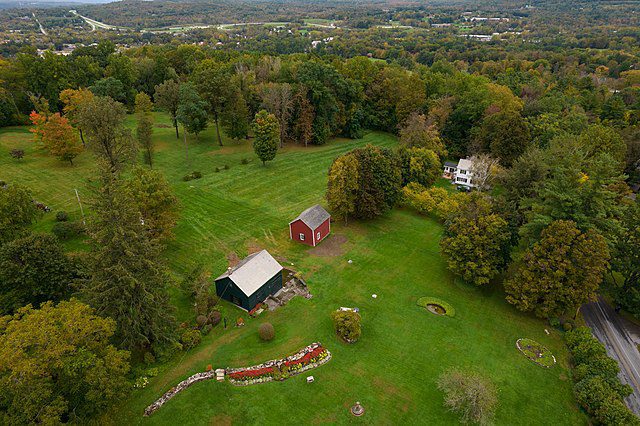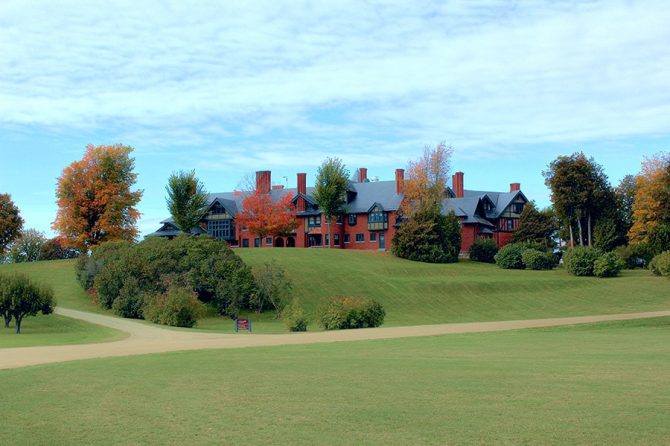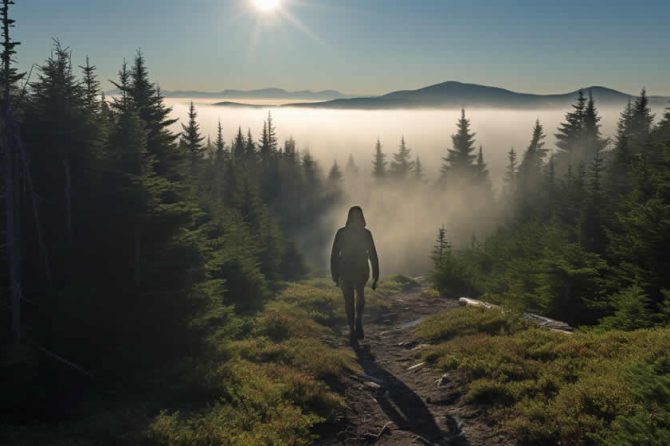Bermuda Triangle is very well known, but not quite so well known is the “Bennington Triangle”
…the name given to a mysterious area in southwestern Vermont, by author Joe Citro, describing an area in which a number of people went missing between 1920 and 1950. Primarily known for the Battle of Bennington, the region is rich in historical events dating back to the 1700’s. Bennington is fertile ground for ghostly events, folklore and supernatural occurrences. The region is often referred to as the “Bennington Triangle” due to the many odd, unexplained happenings within its surroundings, buildings and nearby mountains.
Native Americans consider Glastenbury Mountain “cursed” and used it strictly for burying their dead. Locals also know of the legend, as well as tales of hairy “wild men” and other strange beasts in the woods. They believed the land to be cursed because all four winds met in that spot. There is also mention in native American folklore of an enchanted stone which is said to swallow anything that steps on it.
Over the years there have been between 30-40 unexplained disappearances on the mountain. It is known for certain that at least five persons from this area went missing, some of them on Glastenbury Mountain itself, between 1945 and 1950. These include 74 year-old Middie Rivers, 68 year-old James Tedford, 8 year-old Paul Jepson, 18 year-old Paula Welden, and 53 year-old Frieda Langer. Of these remains of only one was found, that of Frieda Langer.
Most reports on the subject view the circumstances as mysterious, as her body turned up in some tall grasses in an area that had been searched extensively a number of times in the seven months between her disappearance and the discovery of the corpse in an area that had been searched many times, making it unlikely that the search teams had simply missed her. There were several strange circumstances surrounding these disappearances. These are just a few examples of people who have come up missing in the area.
Because of the wide ranges of age and gender of the missing persons, it is thought that the possibility of them being victims of a serial killer is unlikely. This, combined with a lack of any evidence to offer support for any more prosaic explanation, has led many to speculate on possible paranormal causes, including abduction by UFO occupants, “cross dimensional wormholes”, or attack by the “Bennington Monster.” The trails stop partially up the mountain, suggesting that no one goes up there. When you walk into the woodlands of Glastenbury Mountain you don't hear anything living, it's as though even the animals don't dare to venture there.
Image used courtesy of Wikimedia Commons
The book Glastenbury: The History of a Vermont Ghost Town by Tyler Resch provides a comprehensive look at the history of the remote town of Glastenbury, Vermont. Some key facts:
- Glastenbury is located in a rugged, remote area of southern Vermont, much of which is now part of the Green Mountain National Forest.
- The town has a long history dating back to the 1700s when it was granted by the British crown. Its early settlement and development were impacted by events like the French and Indian Wars.
- In the 1800s, industries like logging and charcoal production thrived in Glastenbury. Remnants of old charcoal kilns still exist there today.
- The town is probably best known for some unsolved mysteries and disappearances that happened there in the 1900s, including the shooting of John Harbour and the disappearances of Middie Rivers and Paula Weldon.
- The author Resch takes a factual, objective approach in chronicling the town's history. He does not sensationalize the mysterious disappearances.
- Today over 95% of Glastenbury is protected public land, thanks to its incorporation into the National Forest system.
FAQ:
Q: Where is Glastenbury located? A: In a remote, mountainous area of southern Vermont, much of which is now part of the Green Mountain National Forest.
Q: What industries historically thrived in Glastenbury? A: Logging and charcoal production were major 19th century industries, fueled by the town's heavily forested landscape.
Q: What are some of the town's unsolved mysteries? A: The shooting of a resident named John Harbour and the disappearances of two women, Middie Rivers and Paula Weldon, in the early 1900s remain unexplained mysteries.
Q: What is the town like today? A: Over 95% of the town's area is now protected national forest land, owned by the public. It remains very remote and sparsely populated.
The Middie Rivers Disappearance
- Middie Rivers was an 8-year-old girl who vanished in 1945 while picking berries with her mother.
- Middie asked to visit a nearby beaver pond and her mother allowed it, but she never returned.
- Extensive search efforts found no trace of Middie despite teams of police, firefighters, and volunteers combing the woods.
- Some theorized she had fallen into an old well or into a bog, but no evidence substantiated this.
- Her disappearance, like others in Glastenbury, led to urban legends about the area being haunted or cursed.
The Paula Weldon Disappearance
- Paula Weldon was a college student who disappeared while hiking on the Long Trail in 1946.
- She was hiking alone and never returned to the camp she was staying at.
- Over 500 volunteers searched for Paula but found no trace just like in Middie's case.
- Some suspected foul play but no culprit was ever found. Speculation ranged from an accident to abduction.
- Paula's disappearance compounded the area's notoriety after Middie's vanishing just a year earlier.
- To this day, no concrete evidence has emerged about what happened to Paula in the woods that day.
The disappearances remain two of Vermont's most confounding unsolved mysteries. Author Tyler Resch takes a measured, factual approach in chronicling them in his book.
- Today over 95% of Glastenbury lies within the Green Mountain National Forest.
- The area was historically remote and rugged, described as “vast, remote and somewhat mysterious.”
- Much of the former town is now public wilderness land protected as part of the National Forest system.
Additional details:
- The Glastenbury Wilderness area covers over 15,000 acres in the Green Mountains.
- It contains the headwaters of the Deerfield River along with Bolles Brook, Kitchen Brook, and several other mountain streams.
- The terrain is extremely remote, rugged, and heavily forested, with elevations exceeding 3,000 feet.
- Recreational activities include hiking, backpacking, fishing, and hunting. There are over 50 miles of hiking trails.
- The Appalachian Trail passes through the Glastenbury Wilderness area as well.
- Wildlife includes black bear, moose, deer, bobcat, ruffed grouse, and a variety of songbirds.
- There are backcountry campsites and shelters for hikers scattered throughout the area.
- Logging is prohibited in the Glastenbury Wilderness in order to preserve the undisturbed forests.
So in summary, the Glastenbury Wilderness is a vast, remote, forested area protected within the National Forest system, which offers opportunities for backcountry recreation and wildlife viewing. The terrain lives up to the “rugged and mysterious”
Thank you for visiting Vermonter.com! Please subscribe to our email list for the latest articles!





